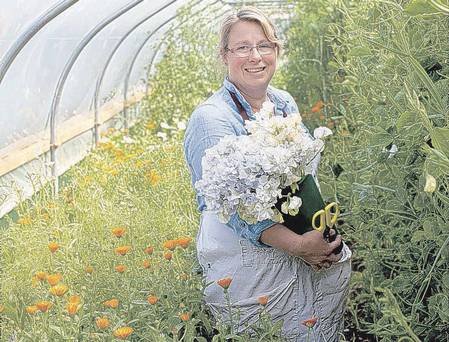Georgie Newbery is explaining how she set up her business, Common Farm Flowers: “It started with bunches of sweet peas at the garden gate.” I’m at her smallholding in Somerset, where long narrow beds are packed with marigolds and honesty, ammi and cornflowers.
The first crop of sweet peas is beginning to flower in the polytunnel where the last of the anemones (beautiful white Anemone “de Caen”) are just going over. Sharon, who helps at the flower farm, is busy cutting branches of wild viburnum, covered in flat white flowerheads, from the windbreak hedges that Georgie and her partner Fabrizio planted when they first arrived.
Emily is weeding the perennial beds: astrantia, grey-leaved artemisia, fountains of cardoon. “Good for big wedding arrangements,” says Georgie. During the last year, she’s done 50 weddings and sent out about 1,500 bouquets of flowers; the jam jars of sweet peas have grown into a proper business.
She has just fulfilled an order for 17 buckets of flowers for a DIY wedding and reckons that 80 per cent of the stuff they sent had been grown on the farm. The other 20 per cent she’d bought in from various other British growers. “Delphiniums for instance. They come on quicker in Cornwall than they do with us.” She never, ever, EVER buys imported flowers. “Who’d want to?” she asks.
Unfortunately, plenty do. Fifty years ago, half the cut flowers bought in this country were home-grown. Now scarcely 10 per cent are. But is this about to change? Georgie’s growing band of customers, she reckons, are “people who care where their meat comes from, people who are beginning to worry about flower miles as much as food miles”. There’s also a growing trend for a more romantic, wild look in bought flowers, a casual (but carefully crafted) sense of the artisan, a desire for flowers that you might have picked from your own garden, if you had one, a nostalgic longing for the unmanufactured. You won’t find that in your average carnation.
“And scent,” says Georgie, sticking her nose in a spray of honeysuckle in the hedge. “Big commercial growers often dunk their flowers in silver nitrate to prolong their shelf life. But that stops the flower from developing any scent at all.” Common Farm is run organically and the half of the seven acres that isn’t used for flowers is managed for the benefit of the local wildlife. The wildflower meadow supplies both. It draws in plenty of insects, but Georgie also uses it to gather buttercups and plantain.
There are an increasing number of small growers producing cut flowers for the home market (you can find over 200 of them listed on flowersfromthefarm.co.uk). And there are flower arrangers such as Ellie Jauncey and Anna Day of the Flower Appreciation Society, whose Hackney studio I wrote about two years ago (you can find them attheflowerappreciationsociety.co.uk). Ellie and Anna are equally messianic about using British flowers, but buy them from New Covent Garden market.
Since Georgie has now built up a loyal band of customers, wouldn’t it be easier, I ask, if she gave up growing and concentrated on arranging? “Easier perhaps, but not as satisfying,” she replies. “There are certainly more small growers around, but I could never buy in the incredible range of stuff we can pick here.” She points at the tiny acid-green flowers and glaucous leaves of Bupleurum rotundifolium in the posy on the table. “That’s one of our most useful fillers. We cut it from April all the way through to September. I do five separate sowings of seed – February, March, April, May and September. But I couldn’t depend on its being there for us unless I was growing it myself.”
Because she’s sending flowers directly from farm to customer, she has several days start on commercial florists. She can use wonderful, wild-looking, scented roses such as “Shropshire Lass”, which wouldn’t have sufficient shelf-life for a wholesaler to bother with.
And then there’s the reason that she, Fabrizio and their two babies came to the smallholding in the first place. They wanted to find some way of earning a living that was ethical, sustainable, and environmentally sound. They fell into flower farming by accident, but the business has now grown enough to provide a living.
Georgie made £7,000 in her first year, making up her arrangements mostly from annuals she’d grown from seed. Now she grows masses of perennials and shrubs as well. She’s just planted a little grove of 20 crab apples. They are only two years old, but already she has raided the trees for blossom. “And we’ll be able to cut branches for fruit in the autumn,” she adds. She’d like to grow more hydrangeas, but they don’t much like her heavy clay soil.
Roses love it though, and each year she plants as many new bushes as she thinks she can afford to buy. It’s only a small dent in the 200 million roses that are imported every year for Valentine’s Day. “But it’s a dent,” she says cheerfully.
This month, Georgie will be sowing biennials including foxgloves, Sweet Williams and a new honesty, “Corfu Blue”, to plant out in September. The full year of planting and harvesting at Common Farm is laid out in her book The Flower Farmer’s Year (Green Books £19.99). Or you can check out her regular blog posts on commonfarmflowers.com.
View this and more articles on the Belfast Telegraph.
Caption: Flower Power: Georgie Newbery, founder of Common Farm Flowers in Somerset, atg work in her greenhouse




